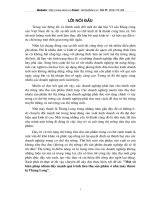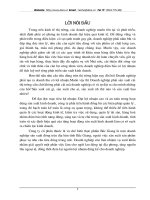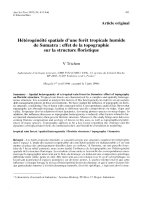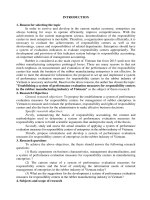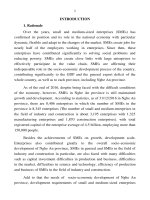- Trang chủ >>
- Thạc sĩ - Cao học >>
- Luật
La nguyenthithuyvan sum
Bạn đang xem bản rút gọn của tài liệu. Xem và tải ngay bản đầy đủ của tài liệu tại đây (141.37 KB, 6 trang )
INTRODUCTION
1. Rationale
Industrialization and modernization are the indispensable
development trend of all nations, especially developing countries such as
Vietnam. Industrialization and modernization aim at achieving a
comprehensive social development of economic, society and
environmental with a high economic growth and economic restructuring
towards reducing the proportion of agriculture and increasing the export
of industrial products... Up to now, many countries have completed
industrialization and they are moving towards a modern economy - the
knowledge economy. However, there are many countries, including
Vietnam, are in the process of implementing industrialization and
modernization. Derived from reality of 30 years of national renewal, the
Party and State have identified industrialization and modernization as the
right way to leave the country out of poverty and backward. Therefore,
the study of (internal and external) resources to implement
industrialization and modernization is very necessary.
Many empirical studies show that foreign direct investment (FDI)
plays an important role on the process of industrialization and
modernization in countries, especially in developing countries such as
Vietnam through positive impact in economic growth, economic
restructuring, labor restructuring, improve national scientific and
technology level (Krongkaew, 1995, Phung Xuan Nha, 2000, Do Thi
Thuy, 2001; Jomo, 2001; Peng, 2010). Are these conclusions in previous
studies on the role of FDI in the process of industrialization and
modernization still true in the context of a provincial level in a
developing country? This study aims to test hypothesis about the impact
of FDI on the process of industrialization and modernization in a
provincial level at Thai Nguyen province.
Thai Nguyen is a province in the Northern Midlands and
Mountains (NMM) of Vietnam, the cultural and educational center of the
region. In recent years, Thai Nguyen has promoted its internal strength
together with utilizing external resources to boost the industrialization
process, soon bringing Thai Nguyen into a modern industry province
according to the Provincial Party Resolution. During the local
industrialization and modernization process since the re-establishment of
the province in 1997, Thai Nguyen has achieved many achievements in
all fields of economy, sociocultural and environmental protection.
Province’s economic growth has continuously increased through the
development stages, the economic structuring towards increasing the
proportion of industry and services, reducing the proportion of
agriculture. The labor force of Thai Nguyen province has also shifted
positively, in which the proportion of agricultural labor tends to decrease
and the proportion of industrial and service labor tends to increase. The
process of urbanization in the province took place at a fairly fast pace.
After nearly 20 years since the re-establishment of the province, the
proportion of urban population in 2015 was 34.11%, increase 13.4%
compared to the urban population in 1997 was 20.7%.
Together with the process of industrialization and modernization,
the operation of attracting and using FDI in Thai Nguyen province has
been increasingly effective. The number of projects, the scale of the
projects and the disbursement rate tend to increase, especially in recent
years. FDI inflows to the province are concentrated in the industry,
accounting for 98.9% of registered capital and 99.72% of performing
capital, contributing to boosting the industry and other economic sectors
and change the appearance of Thai Nguyen province towards
modernization.
Evidence from empirical studies shows the positive impact of FDI
and the FDI sector on Vietnam's industrialization process. However, the
debate on the impact of FDI on industrialization or modernization as the
basis for FDI attraction remains unanswered. The empirical results on the
relationship between FDI and industrialization, especially the impact of
FDI on the industrialization process, are aimed at facilitating the FDI
management and attracting, further enhancing the contribution of FDI to
industrialization, speeding up the pace of industrialization at the
provincial level such as Thai Nguyen is an urgent requirement for both
1
2
research and practical management. Thus, the author selected the topic
"Study the impact of foreign direct investment on industrialization in
Thai Nguyen province" to study the impact of FDI on Thai Nguyen
industrialization, then propose policy solutions to mobilize and
efficiently use FDI capital in association with accelerating the process of
industrialization and modernization of the province.
2. Research objective and research questions
2.1. Research objective
The general objective of this dissertation is to study the impacts of
FDI on industrialization in Thai Nguyen province. Based on the results of
research, recommendations are proposed to promote the industrialization
process in Thai Nguyen province in the future.
The specific objectives of the dissertation are:
- Overview of theoretical and empirical studies on industrialization
and the impact of FDI on industrialization at the national and local levels,
thereby identifying criteria and specifications for industrialization at
provincial level local to use in this study;
- Systematize, explain and implement theoretical issues on FDI,
industrialization and the impact of FDI on industrialization;
- Analyze the status of FDI, the process of industrialization and the
role of FDI in industrialization in Thai Nguyen province;
- Analyze the impact of FDI on Thai Nguyen industrialization;
- Propose recommendations to enhance the role of FDI in order to
promote the industrialization process in Thai Nguyen province.
2.2. Research questions
To achieve the above objectives, the dissertation will focus on
following research questions:
- How is industrialization measured?
- In theory, how does FDI affect the industrialization process?
- What is the situation of FDI and industrialization in Thai Nguyen
province?
- How is the relationship between FDI and industrialization in Thai
Nguyen province? What is the impact of FDI on industrialization in Thai
Nguyen in the period 1995-2015?
- What are recommendations to enhance the roles of FDI to
promote industrialization in Thai Nguyen province in the future?
3. Research subject and scope
3.1. Research subject
The main subject of this dissertation is FDI, industrialization and
the impact of FDI on the industrialization process in a provincial level.
Industrialization is measured by a system of indicators, specification,
especially the “industrialization index” reflecting the aspects of
development about economic, social and environmental.
3.2. Research scope
- Scope of space: the dissertation is conducted to research the
impact of FDI on industrialization in Thai Nguyen province, Vietnam.
- Scope of time: data and documents were analyzed to clarify the
impact of FDI on Thai Nguyen industrialization in the period of 1995 2015.
- Scope of content: the dissertation analyzes the situation of FDI
activities, industrialization process and the impact of FDI on Thai
Nguyen industrialization, in which focus on the role of FDI in
industrialization process through analyzing the role of FDI in basic
indicators to measure industrialization.
4. Significance of the dissertation
4.1. Significance in theory
- The dissertation explained and implemented theoretical issues on
FDI, industrialization and the impact of FDI on industrialization at a
provincial level local.
- The results of the dissertation contribute to providing empirical
evidence on the impact of FDI on industrialization at a provincial level
local in a developing country.
4.2. Significance in practice
3
4
- The dissertation is a valuable scientific work that will be a useful
reference for PhD candidate, graduate students and readers;
- The research results of the thesis will be the basis to build the
development strategies of socio-economic in general, strategies and
policies to attract and use FDI in the process of industrialization in Thai
Nguyen province and other cities, provinces in the country.
5. Structure of the research
Beside the introduction, conclusion and references, the dissertation
includes 5 chapters as the following:
Chapter 1: Literature review related to topic and research
methodology
Chapter 2: Theories background on the impact of FDI on
industrialization
Chapter 3: The situation of FDI and industrialization in Thai
Nguyen province
Chapter 4: The impact of FDI on Thai Nguyen’s industrialization
Chapter 5: Solutions to improve the role of FDI in industrialization
of Thai Nguyen province.
CHAPTER 1: LITERATURE REVIEW RELATED TO THE
TOPIC AND RESEARCH METHODOLOGY
1.1. Literature review related to the topic
1.1.1. Researches on industrialization and measuring industrialization
1.1.1.1. Researches on interlocutory of industrialization
1.1.1.2. Researches on evaluation criteria of industrialization at the
national level
Based on the characteristics of industrialization, the authors Ngo
Thuy Loi and Nguyen Quynh Hoa (2014) propose to use the
"industrialization index" to assess the industrialization process in
Vietnam. This index is calculated by the method of simple average of the
partial industrialization indexes.
1.1.1.3. Researches on criteria measuring industrialization at local level
1.1.2. Researches on impact of FDI on industrialization
1.1.3. The “gaps” in literature review
There have been a lot of international and Vietnamese theoretical
and empirical studies on industrialization, FDI and the impact of FDI on
industrialization at the national as well as provincial level. Researches on
the interlocutory of industrialization and measure criteria of
industrialization are quite adequate and consistent with current trends.
However, there are very few studies using a common index –
industrialization index to measure the process of industrialization,
especially at the provincial level. Therefore, studies on the impact of FDI
on industrialization only analyze the individual effects of FDI on one or
some indicators of industrialization. So far, there is no research
conducted to assess the impact of FDI on industrialization through
evaluating the impact of FDI on the industrialization index at provincial
level local in Vietnam. Conclusions in the literature review also show
that FDI has impact on one or several indicators of industrialization. In
contrast, there are few studies answering the question of whether
industrialization contributes to attracting and effectively using FDI. In
addition, previous studies have mainly used qualitative analysis to
5
6
characterize the role, the negative aspects of FDI attraction associated
with industrialization.
This research will use a combination of socioeconomic indicators
and especially use industrialization index to measure and assess
performing level of industrialization at a provincial level local. The
dissertation also uses quantitative methods such as causal analysis to
clarify the relationship between FDI and industrialization, multivariate
regression analysis to measure the impact of FDI on many basic
industrialization indicators, especially industrialization index. The
conclusions drawn from this dissertation have both theoretical and
practical implications.
CHAPTER 2: THEORIES BACKGROUND ON THE IMPACT OF
FDI ON INDUSTRIALIZATION
1.2. Data and research methodology
2.1. Overview on foreign direct investment
2.1.1. Definition of foreign direct investment
2.1.2. Factors affecting FDI activities in a provincial level local
2.2. Industrialization
2.2.1. Conception of industrialization
2.2.2. Criteria to assess industrialization
2.2.2.1. Economic growth
2.2.2.2. Economic structure
2.2.2.3. Labor structure
1.2.1. Research data
2.2.2.4. Urbanization
In this study, all estimates and hypotheses are based on provincial
data in Thai Nguyen province during 1995 - 2015. 1995 was the first year
that FDI projects were implemented in the province.
2.2.2.5. Industrialization index
The industrialization index is determined basically on the
calculation of component indexes. The component index is determined
by the ratio of the received value of each component indicator with the
standard value of that index (for the indicators receiving values smaller
than or equal to the standard value). The received value of each indicator
is the actual value of a country or a local at a time (usually by year). The
standard value of indicator is usually determined basically on
international experience of countries or locals that have met the industrial
standards, taking into account the actual conditions of the country or
local where the research is conducted. According to the research of Ngo
Thang Loi and Nguyen Quynh Hoa (2014), the industrialization index is
defined by calculating the arithmetic average (simple average) of the
component indicators. The author of the dissertation argues that it is
possible to apply the weighted average method by using the Provincial
Competitiveness Index (PCI) of Vietnam Chamber of Commerce and
Industry (VCCI) to calculate the industrialization index.
2.2.3. The factors affecting industrialization
1.2.2. Research methodology
1.2.2.1. Desk study method
1.2.2.2. Descriptive statistics method
1.2.2.3. Relational analysis method
1.2.2.4. Causal analysis method
1.2.2.5. Regression analysis methods
7
8
2.3. The impact of FDI on industrialization
Table 3.1: The scale of FDI in Thai Nguyen province in the period
1995 – 2015
Year
The
number
of
licensed
projects
Registered
capital
(Million
USD)
Implemented
capital
(Million
USD)
The average
scale per
project
(Million
USD)
Disbursement
rate (%)
CHAPTER 3: THE SITUATION OF FDI AND
INDUSTRIALIZATION IN THAI NGUYEN PROVINCE
1995-2000
12
50,9
48,2
4,24
94,7
2001
2
3,40
0,33
1,70
9,71
3.1. Comparative advantages of Thai Nguyen in attracting FDI and
implementing industrialization
2002
2
3,11
0,8
1,56
25,72
2003
2
4,60
4,16
2,30
90,43
2004
4
148,10
4,12
37,03
2,78
3.1.3. Human Resources
2005
1
6,20
10,58
6,20
170,65
3.1.4. Technological potential
2006
5
3,28
17,59
0,66
536,28
3.1.5. Local government
2007
6
117,45
77,21
19,58
65,74
3.2. The situation of FDI in Thai Nguyen province in the period 19952015
2008
2
3,86
40,28
1,93
1.043,52
2009
2
15,5
7,98
7,75
51,48
2010
3
2,9
20,28
0,97
699,31
2011
1
2,69
18,30
2,69
680,80
2012
5
20,65
8,52
4,13
41,25
2013
22
3.386,75
456,61
153,94
13,48
2014
23
3.163,18
1.052,64
137,53
33,28
2015
25
200,45
3.238,15
8,02
1.615,44
2.3.1. The impact of FDI on economic growth
2.3.2. The impact of FDI on economic and labor restructuring
2.3.3. The impact of FDI on urbanization process
3.1.1. Geo-economic location and natural resources
3.1.2. Economic potential
3.2.1. The result of attracting and using FDI in Thai Nguyen province
3.2.1.1. The scale of attracting and using FDI
In 1995, the first FDI project in Thai Nguyen province was
implemented with the implemented capital of $23.2 million. The scale of
Thai Nguyen's FDI in the period 1995 - 2015 is shown in Table 3.1.
Table 3.1 shows that in the last 3 years, from 2013 to 2015, the
number of FDI projects that Thai Nguyen attracted was 70/117,
accounting for 59.83% of the total number of projects in the period. The
scale of average FDI in the period of 2013 - 2015 is $ 96.43 million.
Tổng số
117
7.133,02
4.962,95
60,97
69,58
Source: Thai Nguyen provincial statistical yearbook 2015 and author’s
calculation
9
10
3.2.1.2. Attracting and using FDI by form of investment
FDI in Thai Nguyen province in the period 1995-2015 was
implemented mainly by the form of 100% foreign capital associating
with the foundation of economic organizations that are FDI enterprises.
3.2.1.3. Attracting and using FDI by economic sectors
FDI projects in Thai Nguyen mainly focus on processing and
manufacturing industry, accounting for 80% the number of projects and
99% the scale of capital.
3.2.1.4. Attracting and using FDI by principal investment partners
By the end of 2015, Thai Nguyen has 9 FDI partners investing in
the province, Korea is the main FDI partner of Thai Nguyen province in
many aspects.
3.2.1.5. Attracting and using FDI by district/borough/city
Although Thai Nguyen already has special preferential policies to
attracting FDI in some mountainous district such as: Dinh Hoa, Vo
Nhai… FDI still focuses on the cities, boroughs having favorable
conditions in infrastructure, human resources… such as Thai Nguyen
city, Song Cong city, Pho Yen district…
3.2.2. General assessment of FDI activities in Thai Nguyen province
3.2.2.1. The achievements
3.2.2.2. The limitations and the reasons
(i) The amount of registered, implemented capital, the scale of
project and disbursement rate have fluctuated over the years and have no
specific trend.
(ii) FDI projects in Thai Nguyen mainly invest in the form of
100% capital, so benefit from FDI attracting is not as expected.
(iii) FDI partners in some developed countries have already
invested in Thai Nguyen, despite of the fact that there is only one project
performed, and there is no new investor from these countries.
The limitations in attracting FDI in Thai Nguyen province in
recent time have subjective and objective causes. Compared with some
vicinity provinces as Vinh Phuc, Bac Ninh… Thai Nguyen’s
geographical position is less favorable for investors in commodity
circulation. In addition, transportation infrastructure and infrastructure of
industrial park has not developed synchronously. Subjective causes are
due to inadequate awareness of the necessity and role of FDI in the
process of industrialization and modernization of a part of leading and
civil servants of Thai Nguyen province. Besides, some policies of Thai
Nguyen have not really attracted investors in general, foreign investors in
particular, that is:
(i) A number of investment policies are still spread out, without
investment focused, resulting in low investment efficiency;
(ii) The one-stop stop mechanism has not properly promoted,
causing troubles to investors;
(iii) Planning is not well implemented, wasting time for investors
in determining the location of investment, long time of land clearance.
3.3. The situation of industrialization of Thai Nguyen Province
3.3.1. Economic growth
3.3.2. Economic restructuring
3.3.3. Labor restructuring
3.3.4. Urbanization
3.3.5. Industrialization index of Thai Nguyen province
The results of calculating the industrialization index showed that
the industrialization index of Thai Nguyen province reached 78.34% by
the end of 2015, meaning that it reaches the late stage 2 (the stage of
development - basically becoming an industrial province). With the rapid
development in recent years, Thai Nguyen may basically become an
industrial province in the modern direction in short time.
11
12
Unit
Benchmark for
completion of
industrialization
Achievement
of Thai
Nguyen
Industrialization
index
Assessment
of
achievement
of Thai
Nguyen
%
≤1
5,59
17,89
Stage 1
Doctors
12
12
100,00
Complete
stage 3
year
75
73,3
97,73
Late stage 3
%
15
5,9
39,33
Late stage 1
64,63
In the
middle of
stage 2
78,34
Late stage 2
Table 3.7. Industrialization index of Thai Nguyen province in 2015
Indicators
1. GDP/capita
(Goods price)
GDP/capita
Index
2. Structure of
economic sectors
by GDP
- Agriculture –
Forestry - Fishery
- Industry –
Construction
- Trade – Service
Structure of
economic sectors
index by GDP
3. Labor structure
- Agriculture –
Forestry - Fishery
- Industry –
Construction
- Trade – Service
Index of labor
structure by
industry
Structure of
economic
sectors index
4. Rate of
urbanization
Unit
Benchmark for
completion of
industrialization
Achievement
of Thai
Nguyen
Industrialization
index
USD
3282
1.993
60,73
%
60,73
%
≤ 15
16,9
88,76
%
46 - 47
50,0
100,08
%
33,1
38 - 39
%
85,97
94,09
Assessment
of
achievement
of Thai
Nguyen
5. Population
Early stage 2 growth
6. The number of
Early stage 2 doctors /10.000
people
7. Average life
expectancy
Complete 8. Percentage of
stage 2 students in total
Complete population
stage 3
Complete
stage 2
≤ 30
51,00
58,82
Early stage 2
%
≥ 38
27,2
71,58
%
≥ 32
21,8
68,13
In the middle
of stage 2
Early stage 2
%
66,18
Early stage
2
%
80,13
Complete
stage 2
68,20
Early stage 2
> 50
34,11
13
(ii) FDI and economic growth have positive relationship; when
FDI increases, economic growth also increases and vice versa.
(iii) FDI has a positive impact on economic restructuring process
towards industrialization.
(iv) FDI promotes the labor restructuring process by sector and by
economic sector in the right industrialization direction.
(v) FDI has positive and high correlated with urbanization process.
(vi) FDI has positive and high correlated with the industrialization
index of Thai Nguyen province.
4.3. Causal analysis of the relationship between FDI and
industrialization in Thai Nguyen province
4.3.1. Unit root test
The results of unit root test show that, beside the labor structure
variable stopping at the original chain, the FDI chain, industrial output,
GDP per capita, economic restructuring, urbanization and
industrialization index are 1-order stationary time series. This means that
the first-order differential of time series in this study is the stationary
chain.
The results of the unit root tests also show that the optimal latency
for FDI variables, industry value added, GDP per capita, economic
restructuring, urbanization and industrialization index is 1.
4.3.2. Co-integration test
The results of co-integration test show that:
(i) There is a co-integration between FDI and industrial value
added (industrial GDP), between FDI and industrialization index.
(ii) There are two co-integrations between FDI and other
industrialization variables.
This test result demonstrates that the relationship between FDI and
industrialization has a linear relationship and reaches stationary state.
4.3.3. Causal test
The results of Granger-Wald test in table 4.5 show that there is a
causal relationship between FDI and industrialization variables. In that,
15
Social index
Industrialization
Late stage 3 index
%
%
Indicators
Source: Thai Nguyen provincial statistical yearbook 2015 and author’s
calculation
CHAPTER 4: THE IMPACT OF FDI ON THAI NGUYEN’S
INDUSTRIALIZATION
4.1. The role of FDI in industrialization of Thai Nguyen province
4.1.1. The role of FDI in economic growth
4.1.2. The role of FDI in economic and labor restructuring
4.1.3. The role of FDI in urbanization process
4.2. Correlation analysis the relationship between FDI and
industrialization in Thai Nguyen province
The result of calculating the correlation coefficient between FDI
and industrialization measurement variables shows that:
(i) FDI and GDP of Thai Nguyen province have positive
relationship and high correlation.
14
FDI impacts all industrialization variables at a statistical significance
level of 1%.
The results of two-stage Granger test show that FDI has impact on
almost all industrialization measurement variables in long-term.
Table 4.5: The results of Granger test
Granger- Wald
Test
FDI decide on economic
growth
Economic growth impacts
on FDI
FDI decides on the value
added of industry
Industry value added
impacts on FDI
FDI decides on economic
restructuring
Economic restructuring
impacts on FDI
FDI decides on labor
restructing
Labor restructing impacts on
FDI
FDI decides on urbanization
Urbanization impacts on
FDI
FDI decides on
industrialization
Industrialization impacts on
FDI
10,296***
(0,001)
0,9524
(0,329)
10,179***
(0,001)
0,1248
(0,724)
7,45***
(0,006)
0,0159
(0,900)
12,019***
(0,001)
7,603***
(0,006)
24,823***
(0,000)
4,7412**
(0,029)
34, 277***
(0,000)
0, 5978
(0, 439)
Two-stage Engle-Granger
test
Short term
Long term
0,0157
0,0291*
(0,065)
(0,166)
0,0533*
(0,081)
0,0417**
(0,024)
-3,054
(0,487)
0,3795
(0,181)
-0,2825
(0,702)
0,1333
(0,436)
0,0024
(0,822)
-14,2004
(0,305)
-0,0008
(0. 884)
15, 6006
(0, 374)
0,9523**
(0,032)
-0,0747
(0,671)
0,0135*
(0,067)
16,1119
(0,317)
0,0064*
(0, 066)
-15,5897
(0,804)
*** statistical significance level of 1% and ** at 5%, and * at 10%. The
number in parentheses is the value of p.
Source: Calculation of dissertation
16
(i) The estimated results show that 98.55% of the change in Thai
4.4. The impact of FDI on Thai Nguyen’s industrialization
4.4.1. Estimated model
Nguyen's economic growth over the period was explained by the impact
4.4.2. Estimated result
of FDI, domestic capital, and labor. Specifically, when the FDI increased
Table 4.6: Estimated result of the impact of FDI on industrialization
1%, the GDP per capita in Thai Nguyen increased 0.0288% in the
statistically significant 5%.
measurement variables of Thai Nguyen province
Economic
growth
(GDP/capita)
**
FDI
Economic
restructuring
(The pace of
economic
restructuring)
**
0,0288
0,7605
(0,036)
(0,029)
4,6136
Labor
restructuring
(The pace of
labor
restructuring)
***
2,7600
(0,002)
Urbanization
(Urban
population)
(ii) Estimated results in Table 4.6 show that 96.14% of the change
Industrialization
index
0,0153
(0,025)
-9***
1,96.10
FDI increased 1%, the economic restructure increased 0.7605%.
(0,001)
-8**
Domestic
capital
- 0,0523
1,08.10
(0,455)
(0,017)
Labor
3,7724***
23,6807**
0,8404***
5,46.10-7**
(0,000)
(0,014)
(0,000)
(0,029)
(0,016)
R-squared
restructuring. In which, the FDI increased 1 million dong, the labor
restructuring raised 2.76 percentage points.
change in urbanization variables is explained by the impact of the
(0,002)
0,0077***
independent variables of the model: FDI, labor size and labor
(0,003)
restructuring. Specifically, when FDI increased by 1%, urban population
0,0475**
Economic
integration
Constant
(iii) The estimated results show that 75.62% of the change in labor
restructuring was explained by the impact of FDI and economic
(iv) The results of the estimation also show that 96.76% of the
0,4147***
Labor
restructuring
effect of independent variables: FDI, domestic capital and labor. In
particular, FDI has a positive impact on economic restructuring and when
**
**
Economic
restructuring
in the pace of economic restructuring of Thai Nguyen is explained by the
increased by 0.0153%.
(0,017)
(v) The estimated results of the impact of FDI on industrialization
index showed that 97.99% changes in the industrialization index was
-47,2498***
-380,306***
5,1628***
1,0297
0,1181
(0,000)
(0,002)
(0,009)
(0,672)
(0,308)
0,9855
0,9614
0,7562
0,9676
0,9799
*** statistical significance level of 1% và ** at 5%. The number in
parentheses is the value of p.
Source: Regression results of the author
Thus, the results of estimating the impact of FDI on the
industrialization measurement variables in Table 4.6 show that:
explained by the impact of FDI, domestic capital, labor and economic
integration. In particular, when FDI increased 1 million, the
industrialization index increased 1.96.10-9 percentage points.
4.5. General assessment on the impact of FDI on Thai Nguyen’s
industrialization
4.5.1. The achievements
4.5.2. The limitations and the reasons
17
18
Above analysis also indicates that industrialization process of the
province in recent time having some limitations:
- The contribution of FDI to growth is unbalanced among
economic sectors, growth of service sector is low;
- Economic restructuring by sectors and the development among
sectors is unbalancing;
- Unbalanced urbanization between districts / cities / towns in the
province.
Attracting and using FDI in Thai Nguyen recently focused on
some areas with advantages as one of the factors causing this situation.
Specifically as follow:
(i) As FDI are mainly concentrated in industry, accounting for
99.72% of the total implemented FDI of the province.
(ii) FDI caused a trade deficit due to a sharp increase in imports of
this sector.
(iii) Imbalance in FDI attraction among districts / cities / towns,
leading to an increase in the development gap among districts in the
province.
Limitations on the impact of FDI on the indicators of Thai
Nguyen’s industrialization are due to subjective and objective reasons.
Objective reasons are due to the impact of political and economic
instability in the world, limited resources to synchronously develop
across sectors, different development advantages in each sector, each
region have great influence of FDI on the industrialization indicators.
Subjective causes include inadequate awareness of the role of FDI in the
industrialization process of a part of the managerial staff; policy
mechanism are not strong enough to obligate investors as committed to
initial business registration in sectors; investment incentives in some key
sectors such as services, incentives in some difficult areas of the province
are not really attractive; the low quality of human resources leads to low
productivity; the weakness of domestic enterprises; the examination and
issuance of investment certificates are not tight and are not fully
complied with the planning; technical and social infrastructure have not
met the requirements; the inspection, examination and supervision of the
implementation of FDI projects is not regular, not really effective.
19
20
CHAPTER 5: SOLUTIONS TO IMPROVE THE ROLE OF FDI IN
INDUSTRIALIZATION OF THAI NGUYEN PROVINCE
5.1. Background to proposed solution
5.1.1. Orientation to attract and use FDI in Vietnam
5.1.1.1. Context of attracting and using FDI
5.1.1.2. Orientation to attract and use FDI
5.1.2. The country industrialization trend
5.1.3. Orientation of industrialization in Thai Nguyen province
5.1.3.1. Background of industrialization in Thai Nguyen province
5.1.3.2. Objectives, viewpoints of industrialization of Thai Nguyen
province
5.1.3.3. Orientation of industrialization in Thai Nguyen province
5.1.4. Orientation to attract FDI to promote the industrialization
process in Thai Nguyen province
5.1.4.1. FDI attraction in Thai Nguyen province
5.1.4.2. Orientation to attract and use FDI
5.2. Solutions to improve the role of FDI to promote Thai Nguyen’s
industrialization
First, improve the awareness, capacity and qualifications of the
leaders, civil servants in Thai Nguyen about the need to attract FDI and
the role of FDI in speeding up the province's industrialization.
Second, complete mechanisms and policies related to attracting
and using FDI associated with the province's industrialization process.
Third, improve the quality of planning by sectors, regions, by
economic sectors, planning industrial parks and industrial clusters in the
province.
Fourth, complete technical and social infrastructure.
Fifth, continue the administrative reform in a simplified way,
promote one-stop-shop mechanism, transparency of information and anticorruption in order to reduce informal expenses related to investment
activities.
Sixth, improve the quality of human resources to meet the
requirements of industries and fields requiring high quality human
resources.
Seventh, improve the management of investment activities in the
province to strengthen the coordination between departments, offices to
avoid overlapping in the implementation process.
Eighth, concern for the promotion of investment, diversification of
forms of investment promotion, promote post-investment support to
attract and retain foreign investors.
Ninth, synchronously develop Thai Nguyen Urban System,
creating momentum for FDI attraction, continued to upgrade urban areas
in depth, accelerating the rate of urbanization.
Tenth, further strengthen the role of FDI in economic growth of
the province.
Eleventh, further strengthen the role of FDI in sectoral economic
restructuring by GDP and labor structure by sector.
Twelveth, international cooperate in the region and other localities
throughout the country on attracting FDI and implementing the process
of industrialization.
21
22
An empirical analysis of the impact of FDI on Thai Nguyen's
industrialization in the period 1995 - 2015 shows that FDI decides to
industrialize in Thai Nguyen province. In particular, FDI has a positive
impact on economic growth, economic restructuring, labor structure and
urbanization. Especially, FDI has a decisive impact on the
industrialization index and causal analysis indicates that this effect is in
the long run.
Base on evaluating the achievements, limitations and causes in
attracting FDI, industrialization and the impact of FDI on the process of
industrialization in Thai Nguyen province in recent time; FDI attraction
context; Orientation of industrialization in Vietnam and Thai Nguyen
province, the author proposed solutions to enhance FDI attraction to
ensure capital for industrialization and promote the industrialization
process in Thai Nguyen province in the future.
Although the dissertation achieved the research objectives, the
author recognizes that many aspects of the thesis need to be further
researched and refined due to provincial data limitations, study time.
Firstly, the data used in the study was not enough for the observation as
the theory had desired. Secondly, the dissertation did not analyze the
spillover effect of FDI on local enterprises in enhancing technology
capacity, improve the localization rate of production and export products,
the ability to associate enterprises of the province involved in the
production and product supply chain globally ...
Although the author has tried to collect sufficient data for the
study, but due to geographical characteristics of the study area, the
dissertation is inevitably limited. The dissertation’s author wishes to be
able to continue to study more about this issue in the coming time and
look forward to the comments of scientists to complete the dissertation.
23
CONCLUSION
The dissertation describes the general picture of FDI and the
industrialization process in Thai Nguyen province. The results of the FDI
situation analysis in Thai Nguyen province show that there have been
many remarkable results, especially the prosperity in recent years. The
process of industrialization in Thai Nguyen province has been in the right
direction, many targets have reached and exceeded the national average.
In addition to the achievements, FDI attraction and the industrialization
process in Thai Nguyen province have also revealed constraints such as
unstable FDI attraction, unbalance among sectors, although the
industrialization moved in the right direction, the speed is still slow,
unbalanced development among sectors and localities in the province.


